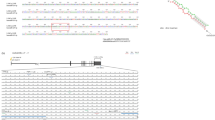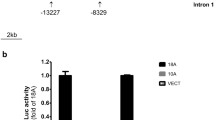Abstract
Human SIRT3 gene contains an intronic VNTR enhancer. A T > C transition occurring in the second repeat of each VNTR allele implies the presence/absence of a putative GATA binding motif. A partially overlapping AP-1 site, not affected by the transition, was also identified. Aims of the present study were: 1) to verify if GATA and AP-1 sites could bind GATA2 and c-Jun/c-Fos factors, respectively; 2) to investigate whether such sites modulate the enhancer activity of the SIRT3-VNTR alleles. DAPA assay proved that GATA2 and c-Jun/c-Fos factors are able to bind the corresponding sites. Moreover, co-transfection experiments showed that the over-expression of GATA2 and c-Jun/c-Fos factors boosts the VNTR enhancer activity in an allelic-specific way. Furthermore, we established that GATA2 and c-Jun/c-Fos act additively in modulating the SIRT3-VNTR enhancer function. Therefore, GATA2 and AP-1 are functional sites and the T S> C transition of the second VNTR repeat affects their activity.
Similar content being viewed by others
References
Ahn, B.H., Kim, H.S., Song, S., Lee, I.H., Liu, J., Vassilopoulos, A., Deng, C.X., and Finkel, T. (2008). A role for the mitochondrial deacetylase Sirt3 in regulating energy homeostasis. Proc. Natl. Acad. Sci. USA 105, 14447–14452.
Allison, S.J., and Milner, J. (2007). SIRT3 is a pro-apoptotic and partecipates in distinct basal apoptotic pathways. Cell Cycle 6, 2669–2677.
Bellizzi, D., Rose, G., Cavalcante, P., Covello, G., Dato, S., De Rango, F., Greco, V., Maggiolini, M., Feraco, E., Mari, V., et al. (2005). A novel VNTR enhancer within the SIRT3 gene, a human homologue of SIR2, is associated with survival at oldest ages. Genomics 85, 258–263.
Bellizzi, D., Dato, S., Cavalcante, P., Covello, G., Di Cianni, F., Passarino, G., Rose, G., and De Benedictis, G. (2007). Characterization of a bidirectional promoter shared between two human genes related to aging: SIRT3 and PSMD13. Genomics 89, 143–150.
Chiu, R., Boyle, W.J., Meek, J., Smeal, T., Hunter, T., and Karin, M. (1988). The c-Fos protein interacts with c-Jun/AP1 to stimulate transcription of AP1 responsive genes. Cell 54, 541–552.
Cooper, H.M., and Spelbrink, J.N. (2008). The human Sirt3 protein deacetylase is exclusively mitochondrial. Biochem. J. 411, 279–285.
Dannenberg, L.O., Chen, H.J., and Edenberg, H.J. (2005). GATA-2 and HNF-3beta regulate the human alcohol dehydrogenase 1A (ADH1A) gene. DNA Cell. Biol. 24, 543–552.
Dorfman, D.M., Wilson, D.B., Bruns, G.A., and Orkin, S.H. (1992). Human transcription factor GATA-2. J. Biol. Chem. 267, 1279–1285.
Haigis, M.C., and Guarente, L.P. (2006). Mammalian sirtuins - emerging roles in physiology, aging, and calorie restriction. Genes Dev. 20, 2913–2921.
Hallows, W.C., Lee, S., and Denu, J.M. (2006). Sirtuins deacetylate and activate mammalian acetyl-CoA synthetases. Proc. Natl. Acad. Sci. USA 103, 10230–10235.
Kawana, M., Lee, M.E., Quertermous, E.E., and Quertermous, T. (1995). Cooperative interaction of GATA-2 and AP1 regulates transcription of the endothelin-1 gene. Mol. Cell. Biol. 15, 4225–4231.
Lombard, D.B., Alt, F.W., Cheng, H.L., Bunkenborg, J., Streeper, R.S., Mostoslavsky, R., Kim, J., Yancopoulos, G., Valenzuela, D., Murphy, A., et al. (2007). Mammalian Sir2 homolog SIRT3 regulates global mitochondrial lysine acetylation. Mol. Cell. Biol. 27, 8807–8814.
Mahlknecht, U., Ho, A.D., and Voelter-Mahlknecht, S. (2006). Chromosomal organization and fluorescence in situ hybridization of the human Sirtuin 6 gene. Int. J. Oncol. 28, 447–456.
Majewski, J., and Ott, J. (2002). Distribution and characterization of regulatory elements in the human genome. Genome Res. 12, 1827–1836.
Marine, J., and Winoto, A. (1991). The human enhancer-binding protein Gata3 bind to several T-cell receptor regulatory elements. Proc. Natl. Acad. Sci. USA 88, 7284–7288.
Masuda, A., Yoshikai, Y., Kume, H., and Matsuguchi, T. (2004). The interaction between GATA proteins and activator protein-1 promotes the transcription of IL-13 in mast cells. J. Immunol. 173, 5564–5573.
Michan, S., and Sinclair, D. (2007). Sirtuins in mammals: insights into their biological function. Biochem. J. 404, 1–13.
North, B.J., and Sinclair D.A. (2007). Sirtuins: a conserved key unlocking AceCS activity. Trends Biochem. Sci. 32, 1–4.
Ohneda, K., and Yamamoto, M. (2002). Roles of hematopoietic transcription factors GATA-1 and GATA-2 in the development of red blood cell lineage. Acta Haematol. 108, 237–245.
Patient, K.J., and MacGhee, J.D. (2002). The GATA family (vertebrates and invertebrates). Curr. Opin. Genet. Dev. 12, 416–422.
Perkins, K.J., and Davies, K.E. (2003). Ets, Ap-1 and GATA factor families regulate the utrophin B promoter: potential regulatory mechanisms for endothelial-specific expression. FEBS Lett. 538, 168–172.
Rose, G., Dato, S., Altomare, K., Bellizzi, D., Garasto, S., Greco, V., Passarino, G., Feraco, E., Mari, V., Barbi, C., et al. (2003). Variability of the SIRT3 gene, human silent information regulator Sir2 homologue, and survivorship in the elderly. Exp. Gerontol. 38, 1065–1070.
Scher, M.B., Vaquero, A., and Reinberg, D. (2007). SirT3 is a nuclear NAD+-dependent histone deacetylase that translocates to the mitochondria upon cellular stress. Genes Dev. 21, 920–928.
Schlicker, C., Gertz, M., Papatheodorou, P., Kachholz, B., Becker, C.F., and Steegborn, C. (2008). Substrates and regulation mechanisms for the human mitochondrial sirtuins Sirt3 and Sirt5. J. Mol. Biol. 382, 790–801.
Schwer, B., Bunkenborg, J., Verdin, R.O., Andersen, J.S., and Verdin, E. (2006). Reversible lysine acetylation controls the activity of the mitochondrial enzyme acetyl-CoA synthetase 2. Proc. Natl. Acad. Sci. USA 103, 10224–10229.
Shaulian, E., and Karin, M. (2002). AP-1 as a regulator of cell life and death. Nat. Cell. Biol. 4, E131–E136.
Shi, T., Wang, F., Stieren, E., and Tong, Q. (2005). SIRT3, a mitochondrial sirtuin deacetylase, regulates mitochondrial function and thermogenesis in brown adipocytes. J. Biol. Chem. 280, 13560–13567.
Tong, Q., Dalgin, G., Xu, H., Ting, C.N., Leiden, J.M., and Hotamisligil, G.S. (2000). Function of GATA transcription factors in preadipocyte-adipocyte transition. Science 290, 134–138.
Tong, Q., Tsai, J., and Hotamisligil, G.S. (2003). GATA transcription factors and fat cell formation. Drug News Perspect. 16, 585–588.
Tsai, F.Y., and Orkin, S.H. (1997). Transcription factor GATA-2 is required for proliferation/survival of early hematopoietic cells and mast cell formation, but not for erythroid and myeloid terminal differentiation. Blood 89, 3636–3643.
Verde, P., Casalino, L., Talotta, F., Yaniv, M., and Weitzman, J.B. (2007). Deciphering AP-1 function in tumorigenesis: fra-ternizing on target promoters. Cell Cycle 6, 2633–2639.
Voelter-Mahlknecht, S., and Mahlknecht, U. (2006). Cloning, chromosomal characterization and mapping of the NAD-dependent histone deacetylases gene sirtuin 1. Int. J. Mol. Med. 17, 59–67.
Voelter-Mahlknecht, S., Ho, A.D., and Mahlknecht, U. (2005). FISH-mapping and genomic organization of the NAD-dependent histone deacetylase gene, Sirtuin 2 (Sirt2). Int. J. Oncol. 27, 1187–1196.
Voelter-Mahlknecht, S., Letzel, S., and Mahlknecht, U. (2006). Fluorescence in situ hybridization and chromosomal organization of the human Sirtuin 7 gene. Int. J. Oncol. 28, 899–908.
Yamashita, K., Discher, D.J., Hu, J., Bishopric, N.H., and Webster, K.A. (2001). Molecular regulation of the endothelin-1 gene by hypoxia. Contributions of hypoxia-inducible factor-1, activator protein-1, GATA-2, and p300/CBP. J. Biol. Chem. 276, 12645–12653.
Yang, H., Yang, T., Baur, J.A., Perez, E., Matsui, T., Carmona, J.J., Lamming, D.W., Souza-Pinto, N.C., Bohr, V.A., Rosenzweig, A., et al. (2007). Nutrient-sensitive mitochondrial NAD+ levels dictate cell survival. Cell 130, 1095–1107.
Zhou, H., Zarubin, T., Ji, Z., Min, Z., Zhu, W., Downey, J.S., Lin, S., and Han, J. (2005). Frequency and distribution of AP-1 sites in human genome. DNA Res. 12, 139–150.
Author information
Authors and Affiliations
Corresponding author
About this article
Cite this article
Bellizzi, D., Covello, G., Di Cianni, F. et al. Identification of GATA2 and AP-1 Activator elements within the enhancer VNTR occurring in intron 5 of the human SIRT3 gene. Mol Cells 28, 87–92 (2009). https://doi.org/10.1007/s10059-009-0110-3
Received:
Revised:
Accepted:
Published:
Issue Date:
DOI: https://doi.org/10.1007/s10059-009-0110-3




